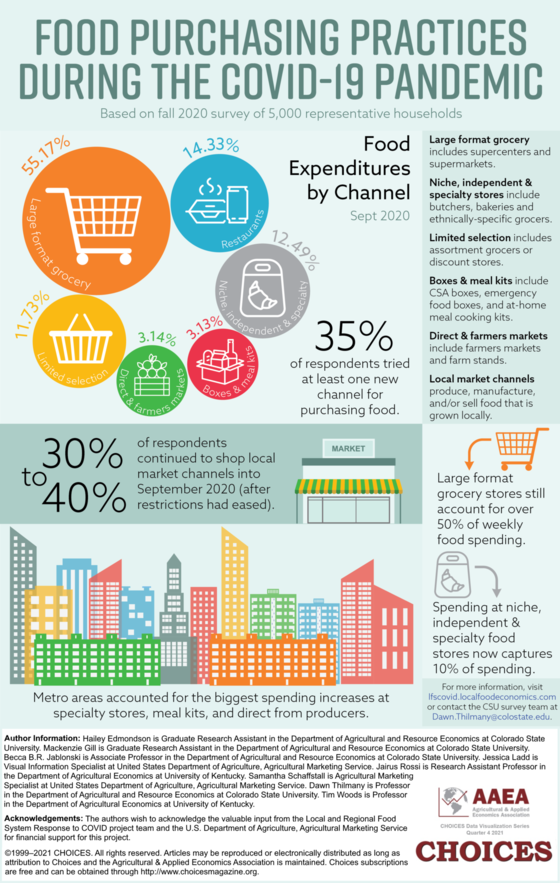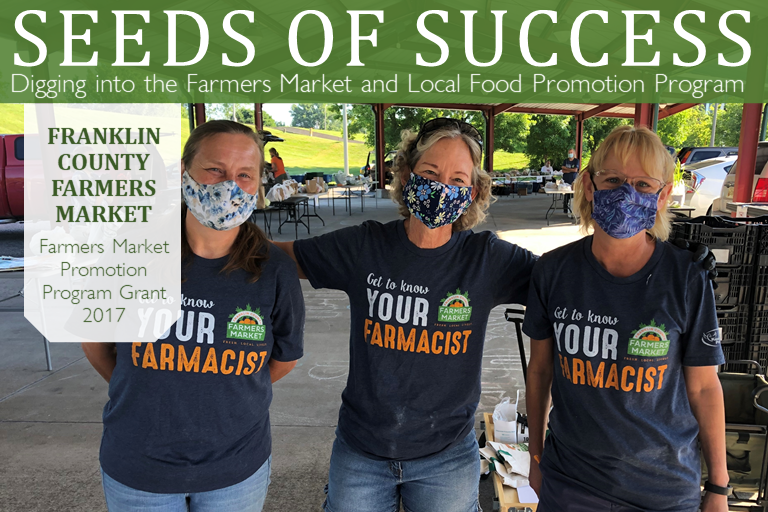|
Local Food Purchase Assistance Cooperative Agreements Program

AMS is now accepting applications for the Local Food Purchase Assistance Cooperative Agreement Program (LFPA). The LFPA program is part of the “Build Back Better” initiative, authorized by the American Rescue Plan.
The purpose of this program is to maintain and improve food and agricultural supply chain resiliency and it will award up to $400 million through non-competitive cooperative agreements with state and tribal governments to support local, regional, and socially disadvantaged farmers and ranchers through the purchase of domestic local foods. Local and regional farmers and ranchers are those within the state or territory, or 400 miles, of a delivery destination.
The cooperative agreements will allow for state and tribal governments to procure and distribute local and regional foods and beverages that are healthy, nutritious and unique to their geographic area. The food will meet the needs of the population, and serve feeding programs, including food banks, schools and organizations that reach underserved communities. In addition to increasing local food consumption, funds will help build and expand economic opportunity for local and socially disadvantaged producers. State and tribal governments can apply now for the LFPA Program at www.grants.gov
Farm and Food Workers Relief Grant
USDA is accepting applications for the new Farm and Food Workers Relief (FFWR) grant program. The program will provide $665 million to fund competitive grant applications to provide relief to farmworkers and meatpacking workers who incurred pandemic-related health and safety costs. Eligible state agencies, tribal entities and non-profit organizations serving farmworkers and meatpacking workers can apply now through Feb. 8, 2022, at www.grants.gov for grants ranging from $5 million to $50 million.
AMS will hold an informational webinar for eligible organizations (i.s. State agencies, Tribal entities and non-profit organizations) interested in applying for the Farm and Food Workers Relief (FFWR) Grant Program on Friday, Dec. 17, 2021, from 1:00-2:00 p.m. ET. The webinar will provide an overview of the grant and application requirements, introduce the technical assistance providers and give information on how to obtain support during the application process. The webinar will be held via ZOOM. Please register for the webinar using the following link: https://us02web.zoom.us/webinar/register/WN_X79q0IsIRYmXipWuZTO7ag.
Participants are encouraged to submit questions in advance to the FFWR grant program at FFWRGrants@usda.gov.
Farm to School Grant Program – Applications due January 10
USDA’s Food and Nutrition Service expects to award approximately $12 million in competitive grants to eligible entities through the Farm to School Grant Program in FY 2022. Each grant helps implement farm to school programs that increase access to local food in Child Nutrition Program meals, connect children with agriculture for better health, and inspire youth to consider careers in agriculture. Since the program’s inception in 2013, USDA has awarded nearly $64 million through Farm to School Grants, funding 896 projects across all 50 states, the District of Columbia, U.S. Virgin Islands, Guam, and Puerto Rico, reaching over 22 million students in more than 54,000 schools.
|
Farmers Market and Local Food Promotion Program Grants Awarded
On November 23, USDA announced a $90.2 million investment in 203 projects to strengthen and explore new market opportunities for local and regional food businesses through the Farmers Market and Local Food Promotion Programs (FMLFPP) and the Regional Food System Partnerships (RFSP).
- FMLFPP awarded a total of $75.4 million to 172 projects across 41 states to support the development, coordination, and expansion of direct producer to consumer markets and local and regional food business enterprises. FMLFPP is implemented through two components, the Farmers Market Promotion Program (FMPP) and the Local Food Promotion Program (LFPP). FMPP awarded $37.5 million to 84 projects to support direct producer-to-consumer marketing projects such as farmers markets, community-supported agriculture programs, roadside stands, and agritourism. LFPP awarded $37.7 million to 85 projects to develop, improve, and expand local and regional food business intermediary supply chain activities, including processing, distribution, aggregation, and storage of locally or regionally produced food products. Learn more about the FMPP and LFPP awards.
- RFSP awarded $14.8 million to 30 projects across 24 states to support partnerships that connect public and private resources to plan and develop local or regional food systems. The projects focus on strengthening the viability and resilience of regional food economies through collaboration and coordination. Learn more about the RFSP awards.
Social distancing mandates and the subsequent economic disruptions resulting from the COVID-19 pandemic caused unprecedented changes in where, how, and what food U.S. consumers purchased and acquired in 2020.
To better understand these changes, a team of researchers from the Local and Regional Food Systems Response to COVID-19 project —focused on the implications for local and regional food systems—conducted a national survey of over 5,000 households from mid-October to mid-November 2020.
The survey was conducted using a Qualtrics panel. The team set quotas to ensure a demographically balanced sample, with the exception of gender (as we asked the primary food shopper in the household to respond and women were more likely to play that role).
A variety of demographic and COVID-related questions were asked to capture food behavior trends, including: 1) purchases of food through a variety of market channels, 2) use of online platforms, and 3) food security status. Questions gaged consumer behavior over three time periods: September 2019 (prior to the pandemic), April 2020 (the pandemic begins), and September 2020 (several months into the pandemic).
 Food Purchasing Practices During the COVID-19 Pandemic provides insight into where households spent their food dollars. One key innovation of the survey was asking about specific market channel usage, noting which channels were used for the first time during the pandemic (April 2020) and if they continued throughout the pandemic (September 2020). The researchers’ hypothesis is that consumers that used a channel for the first time in April 2020, and were continuing to use that channel in September 2020, are more likely to continue with this shopping behavior post-pandemic.
Check out the two more infographics from the same survey data:
Building on the lessons, impacts, and successes of the Local and Regional Food Systems Response (LRFS) to COVID-19 project, USDA’s new LRFS Recovery and Resilience project asks “What would 2020 have looked like if a collaborative network of research, engagement, and outreach across LRFS stakeholders, university researchers, and USDA leadership had been in place?” The project focuses on translating lessons learned from local food systems stakeholders during the COVID-19 pandemic and simultaneous social crisis into a specific collaborative strategy for fostering recovery, and equitable approaches to LRFS resilience. This will be done by:
-
Continuing cross agency and sector learning, collaboration, and strategic action via a facilitated Network of Networks that convenes organizations leading LRFS stakeholder networks, university-based researchers, and USDA staff and leadership to share urgent and emergent issues, coordinate strategies and programing, and foster cross-stakeholder communication and collaboration.
-
Fostering greater data efficacy and literacy by engaging project stakeholders in completing a gap analysis of existing LRFS data, peer mentorship, and technical assistance for LRFS Data and Metrics
-
Synthesizing findings from data gathered and lessons learned into a Resilience Playbook to support policy makers, funders, and LRFS leaders
-
Continuing to produce publications, technical assistance, and outreach tools including sector snapshots, innovation briefs, cross-sectoral webinars, and data briefs.
While distinct in their focus, each key component of this project (Network of Networks, Data and Metrics, Resilience Playbook) is designed to inform and reinforce the others. The project team are committed to continuing our shared work of building a robust collaborative that weaves together the different expertise and skills of our network members, the power of transparency and mutual accountability with project outputs, and a shared vision for how we can work together to build resilient, just, sustainable, and vibrant regional food systems.
Webinar - The New Normal: How LRFS are leveraging lessons of COVID for current and future disruptions
In our first webinar of the series, we are joined by leaders and innovators from across the nation to discuss how lessons learned during the COVID-19 pandemic are informing the future trajectory of local and regional food systems. Join us as we explore what strategies, relationships, and adaptations are laying a new foundation for vibrant, just, and resilient food systems.
Network of Networks
There are a great number of high-impact organizations that serve LRFS stakeholders at the ground level. Focusing on sector or stakeholder specific issues, these network organizations are well positioned to understand and address those specific needs. However, an unexpected finding from the first year of the LRFS response to COVID project was the practical value of cross-sector convenings.
We found that our cross-sector network provided a reliable space to identify and address shared issues, develop novel collaborative strategies across previously disconnected sectors, and a ready point of inquiry for governmental policy and program leaders seeking to understand and address LRFS issues.
By bringing together food systems network leaders, researchers, and USDA staff, our Network of Networks team works to design soft infrastructure that will identify opportunities and/or risks for LRFS, and coordinate responses accordingly.
Quarterly network convenings provide a platform for identifying cross-sectoral issues and opportunities, and for timely feedback and ground-truthing of project findings and outputs. Convenings will also provide regular and multi-directional communication with USDA leadership to provide robust and timely communication between LRFS stakeholders and federal partners.
Network members can also collaborate with researchers on a deeper dive into sector specific issues, develop case studies of innovative programs, and highlight the work of leaders within their networks. These activities are not required of network members but are supported with modest compensation and allow for members to participate in research activities according to their interest and capacity.
The first meeting will be January 26 at 1:00pm ET.
If you are interested in participating in the Network of Networks, please provide your network’s information by completing the interest form found here.
The National Food Hub Survey is now open! Building on the four previous surveys, the 2021 survey is a collaborative effort from Michigan State University's Center for Regional Food Systems (CRFS) and the Wallace Center at Winrock International. This year’s shorter, voluntary survey is set to provide national data on the economic growth, activities, opportunities, and challenges of food hubs and similar businesses. Respondents can include not just businesses that are a food hub in name, but any organizations that aggregate goods from multiple producers and distribute locally and regionally. Questions about the survey should be directed to Noel Bielaczyc, Value Chain Specialist with Michigan State University’s Center for Regional Food Systems at bielacz1@msu.edu.
Each month, we’re highlighting the work of Farmers Market and Local Food Promotion grant recipients.
Franklin County Farmers Market
 Franklin County Farmers Market is a producer only market located in the historic district of Frankfort Kentucky and received a Capacity Building Farmers Market Promotion Program Grant (FMPP) in 2017 to improve marketing and outreach while also piloting direct marketing opportunities such as a farm to workplace delivery program. As a result of this grant project, Franklin County Farmers Market was able to:
- Increase market sales by 83% from the beginning of the grant period.
- Develop the Farm to Frankfort Workplace Delivery Program to serve seven area workplaces. The development of this program allowed Franklin Country Farmers Market to pivot quickly to online ordering and curbside pickup in response to COVID-19.
- Expand social media presence on Facebook and Instagram. Facebook likes increased by 128% and Instagram follows by 481%.
|